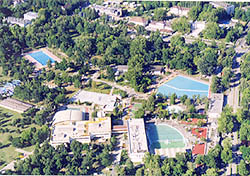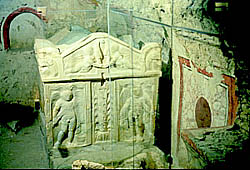|
The southernmost county of Hungary is characterized by Mediterranean atmosphere, a landscape resembling the Tuscan hills, the fiery red wine of Villány and innumerable monuments. Visitors to the slopes of the Mecsek hills can almost feel the pleasant breeze coming from the Mediterranean Sea on their faces.
Due to the pleasant climate, which is considered to be hot in Hungary, rare plants can grow here. In the hills you can find sweet chestnut, almond and fig trees. Owing to the slopes facing south and the plenty of sunshine, the local farmers produce wonderful red wines of harmonic flavours. Villány is a nationally famous wine region, where kadarka and kékoportó are grown. The county is also rich in thermal and mineral waters: e.g. the world-famous thermal bath of Harkány can be found here, the sulphurus water of which is beneficial for different kinds of illnesses, but it also awaits families with attraction bath services including a jacuzzi, a bubble bath, indoor and outdoor pools and chutes.
The county seat, Pécs was inhabited as early as the period of the Roman Empire and it was called Sopianae. The period of early Christianity is represented by the old Christian cemetery found in front of the present cathedral, near Mons Sacrum (Saint hill). The cemetery has been part of the World Heritage since 2000. The two-storey crypt called Peter-Paul is decorated with paintings of biblical topics, while in the Korsós crypt there is a chapel with the pictures of Eden on the walls. Almost exactly one thousand years after the Roman invasion, King Stephen I founded the episcopate of Pécs and the cathedral. The Gothic church with four towers is still one of the most beautiful attractions of Pécs. In the county seat you can also find the first Hungarian university founded by King Louis the Great. Renaissance culture was introduced during the period of bishop Janus Pannonius. The Renaissance collection of stonework finds in the court of the Zsolnay Museum dates back to this period. The name of the city has become inseparable with that of the Zsolnay ceramics: in the museum of the manufacture you can see the history and the typical pieces of the deservedly world-famous Zsolnay ceramics. The busy cultural life of the city is guaranteed by the variety of programmes including the National Theatre Festival of Pécs, too. Festivals are organized not only in summer: the unique carnival in Mohács called busójárás is as colourful as the carnival in Venice. According to the legend, the heroic deed of the "busó" people wearing lambskin coats and frightening devil's masks was not less than to expel the Turks out of the city.
There used to be many border castles in the county, the most intact of which is the castle of Siklós. The majestic, lonely mediaeval castle on the hilltop is really impressive with its irregular rectangular shape. The name of Szigetvár is inseparable from Miklós Zrínyi, who was the leader of the heroic fights against the Turks in 1566. Lodgings in Baranya county:
Sights in Baranya county: |
Baranya county map nagyítása >>
in Baranya county:
|
|
|
Hungary - Baranya county |
|
|
|
||
|
Tuesday, 15. April 2025. - 07:28:40 |
||



